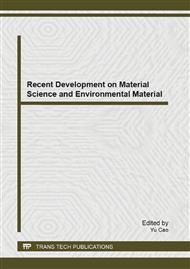[1]
M. Fathi, A. Mefoued, A. Messaoud, Y. Boukennous. Cost-effective photovoltaics with silicon material. Phy. Proc., 2(2009) 751-757.
DOI: 10.1016/j.phpro.2009.11.021
Google Scholar
[2]
N.B. Mason. Industry developments that sustain the growth of crystalline silicon pv output, Proceedings of the Photovoltaic Science, Applications & Technology Conference, 2007, 43-46.
Google Scholar
[3]
D.D. Lawrence , Richardson, D.M. Anderson U.S. Patent 4, 501, 258. (1985).
Google Scholar
[4]
M. Bhagavat, V. Prasad,I. Kao. Elasto-hydrodynamic interaction in the free abrasive wafer slicing using a wire saw: modeling and finite element analysis. J. Tribol, 2000, 122(4) , 394-404.
DOI: 10.1115/1.555375
Google Scholar
[5]
H J. Möller. Basic mechanisms and model of multi wire sawing, Advanced Engineering Materials, 6(2004) , 501-513.
DOI: 10.1002/adem.200400578
Google Scholar
[6]
A. Bidiville,K. Wasmer,R. Kraft,C. Ballif. Diamond wire-sawn silicon wafers-from the lab to the cell Production. Proceedings of the 24th EU PV-SEC, 2009, 1400-1405.
Google Scholar
[7]
K.H. Ho,S.T. Newman,S. Rahimifard R.D. Allen. State of the art in wire electrical discharge machining(WEDM). Int. J. Mach. Tool. Manu, 44(2004) 1247-1259.
DOI: 10.1016/j.ijmachtools.2004.04.017
Google Scholar
[8]
Y.F. Luo, C.G. Chen, Z.F. Tong. Investigation of silicon wafering by wire EDM. J. Mater. Sci, 27(1992)5805-5810.
DOI: 10.1007/bf01119742
Google Scholar
[9]
W.Y. Peng, Y.S. Liao. Study of electriacl discharge machining technology for slicing silicon ingots. J. Mater. Process. Technol, 140(2003)274-279.
DOI: 10.1016/s0924-0136(03)00718-0
Google Scholar
[10]
D. Rakwala, E. Bamberg. Slicing, Cleaning and kerf analysis of germanium wafers machined by wire electrical discharge machining. J. Mater. Process. Technol., 209(2009) 3740-3751.
DOI: 10.1016/j.jmatprotec.2008.08.027
Google Scholar
[11]
W. Wang, Z.D. Liu, Z.J. Tian, Y.H. Huang, Z.X. Liu . High efficiency slicing of low resistance silicon ingot by wire electrical-spark hybrid machining. J. Mater. Process. Technol., 209(2009) 3149-3155.
DOI: 10.1016/j.jmatprotec.2008.07.029
Google Scholar
[12]
C.L. Lee,Y. Kanda,T. Hirai, S. Ikeda, M. Matsumura. Electro-chemical grooving of si wafers using catalytic wire electrodes in HF solution. J. Electrochem. Soc, 156(2009)134-137.
DOI: 10.1149/1.3033735
Google Scholar
[13]
C.L. Lee,Y. Kanda,S. Ikeda, M. Matsumura. Electro-chemical method for slicing Si blocks into wafers using platinum wire electrodes. Sol. Energ. Mat. Sol. C, 95 (2011) 716-720.
DOI: 10.1016/j.solmat.2010.10.009
Google Scholar
[14]
M.S. Salem,C. L Lee,S. Ikeda, M. Matsumura. Acceleration of groove formation in silicon using catalytic wire electrodes for developmen of a slicing technique. J. Mater. Process. Technol., 210 (2010): 330-334.
DOI: 10.1016/j.jmatprotec.2009.09.019
Google Scholar
[15]
M. Yamaguchi ,Y. Abe ,A. Masuda, M. Kondo. Study on silicon-slicing technique using plasma-etching processing. Sol. Energ. Mat. Sol. C, 93 (2009) 789-791.
DOI: 10.1016/j.solmat.2008.09.052
Google Scholar
[16]
J.S. Wang. Sawing mechanism and experimental research for semi-fixed abrasive wire saw. Hangzhou : Zhejiang universty of technology, (2012).
Google Scholar



